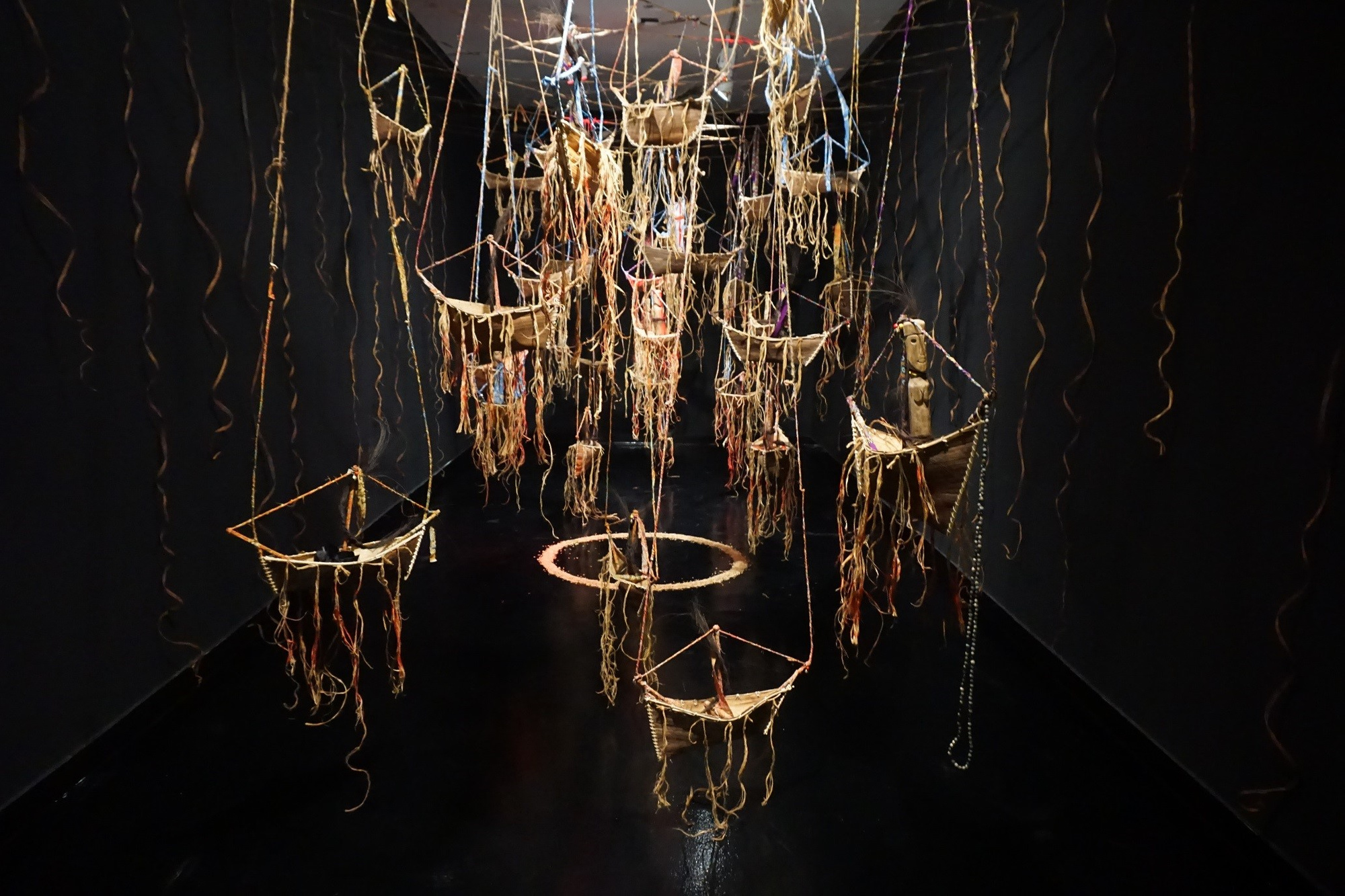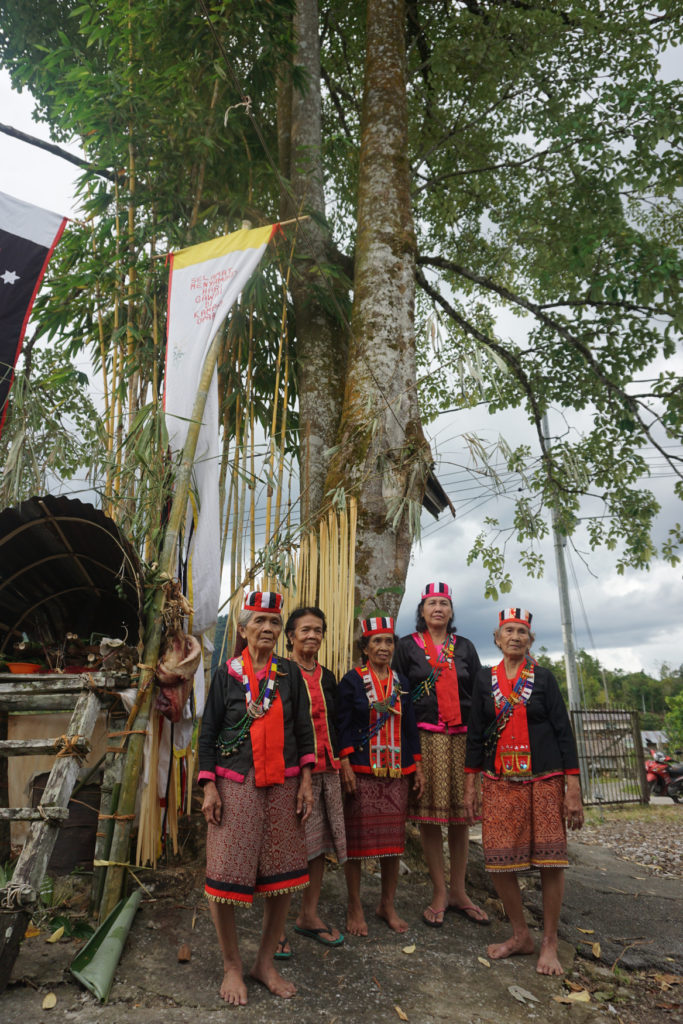
The Dayung Borih, or shaman, play a central role in sustaining Bidayuh culture and belief systems. Dayung Borih (female) and Pinguguoh/Pinyigar (male) serve important functions in many communities’ ritual ceremonies as mediators between humanity and the spiritual world. When in a state of trance, shamans are able to travel to the spirit world to communicate with all types of entities, including the ‘world-spirit’. Generally, shamans discover their spiritual gifts when being summoned upon by a spirit in a dream. When chosen, the candidate normally experiences an episode of serious illness. Undergoing this ordeal and recovering from the illness confirms the shaman’s potency, upon which one is subsequently initiated and recognised as a shaman.
Not all are qualified to be Dayung Borih as they are chosen by the paddy spirit through a dream. I’eng (spirit) come to them in the form of a handsome man. Even when conscious, they would see the i’eng, causing them to be oblivious to everyone else around them. This also makes them fall seriously ill for several years: some almost lose their mind and die. They would try various medications to cure their sickness but would inevitably fail, causing them to lose weight and become emaciated. They can only recover after the appropriate ceremony is held. These are the chosen few who have to undergo rituals, albeit involuntarily, to be Dayung Borih. The process takes a year in order for one to qualify as a Dayung Borih. They must not consume certain foods such as taro, bamboo shoots, wild fern, chicken and pork. Most importantly, they cannot eat deer meat for the rest of their lives. Dayung borih also cannot visit graveyards or attend funerals within her one year of abstention.
In preparation for the ritual, rasang is an important sacred object which serves as a new ‘home’ for the i’eng to inhabit. Symbolically, the ritual also binds the Dayung Borih conjugally to the i’eng. Hence, the rasang symbolises the Dayung Borih’s family in another realm. Additionally, Rasang plays an important role as a sacred object in the Gawea Ngidaan Rasang ceremony during the Gawai festival.
In terms of physical appearance, rasang is a wooden carving in the form of a Ruoi – known in English as a Great Argus, a sacred bird related to the i’eng ritual. The Ruoi is chosen for its beautiful appearance, eyes, feather patterns and colours, especially on its tail. Rasang are made only for women chosen to become a Dayung Borih (shaman). Every Dayung Borih has her own rasang, and the two are bonded for life.
The rasang can be divided into three distinct parts; top, middle and bottom. The carving on top is a male rasang, while the bottom is a female rasang. A storage compartment (the middle) inside the rasang stores the batuh i’eng, which looks roughly like perforated rock crystals, and small wooden carvings such as sinuod (comb), asuol (spears), bisu’ah (paddle) and ba’ie (sword). The head of the rasang is designed as a crown and the shape of the mouth resembles a beak, with jagged lines as teeth. The rasang’s eyes are made from beads, while coconut shells are strung together as a necklace or as earrings. A bead necklace, known as pangieh, decorates the rasang’s neck. A string with bells and beads is placed around the chin. The motifs on the rasang’s tail are wavy and coiled to suggest its tenderness.
Rasang are normally between 1 and 1.5 feet high, and 1.9 to 2.7 feet wide, with multiple wooden ornaments attached, such as the sinuod (comb), asuol (spears), bisu’ah (paddle), ba’ie (sword), cylinder bamboo, and dried leaves. According to the Dayung Borihs, the sizes of the rasang differ depending on the sizes of the i’eng. Rasang are originally painted in dark-red-orange colours. Gradually, as time passes, the paint on the body of the rasang fades to burgundy, while the carved motifs fade into light and dark brown. The motifs on the rasang can be categorized into two types – organic and geometric. Every rasang made has similar motifs, but with slight differences in decoration and carving methods. Some of the motifs on the rasang take inspiration from the male carver’s dreams imparted to them from the i’eng.

Rasang can only be made from the g’tiak tree or the situ tree. G’tiak and situ trees are favoured by i’eng as their wood is of high quality and is very hard and durable. Before they can fall the tree to make rasang, however, they need to perform a gawea ritual ceremony. During the preparation of the ceremony, Dayung Borih will ask the men to carve a wooden rasang for them. A rasang is made over eight days and eight nights during the Adat Dayung Borih ceremony. It is then used as an important sacred object in the Gawai Pribarih Dayung ceremony, to megandam (heal) their illness through a method of pribarih (spirit diversion), allowing these women to emerge from the ceremony as Dayung Borih.
Bidayuh people believe that the rasang has its own rules, for example, no one is allowed to touch or play with the rasang. Males, especially, are not allowed to touch the rasang. Any man touching the rasang will fall sick or turn blind, even though the ones creating and carving the rasang are men. This is because the rasang is a sacred object used for Gawai Pribarih Dayung and Gawea Ngidaan Rasang ceremonies. Besides that, it is a sacred object for Dayung Borih and a home for the i’eng. The rasang is kept for a lifetime by the Dayung Borih and will accompany the shaman to her death bed and burial.
Kendy Mitot is an artist of the indigenous Bidayuh tribe of Sarawak. The Bidayuh represent 8% of the Sarawak population. As an educator, researcher, and fine artist, Kendy’s research areas include topics related to traditional arts and culture of Borneo indigenous people especially the Bidayuh, in Sarawak, Malaysia, as well as his interest into art innovation- media experimentation, art theory and practices. His artworks reflect the Borneo indigenous people especially in myth, symbols, and ritual ceremonies, as well as his experimentations with difference medium as a visual arts practitioner. You may reach him at kendymitot.arts@gmail.com.